
Gloom and Bliss battle for control in Cerebria: The Inside World, a game that takes place within a developing mind.
What Is Cerebria: The Inside World?
Cerebria: The Inside World is an area-control game from Mindclash Games for 2 to 4 players, ages 15 and up, and takes about 2 hours to play. It’s currently on Kickstarter, with a pledge level of $60 (plus shipping) for the base game, or $75 for the “Spirit Box” which will include 8 plastic miniatures and additional stretch goals. It funded within the first 24 hours and has already hit a few stretch goals. The game does not have anything inappropriate for younger players, but it does have a high degree of complexity so it is most suited to experienced gamers.
New to Kickstarter? Check out our crowdfunding primer, and visit our Kickstarter curated page for more projects we love.

(Prototype shown) Photo: Jonathan H. Liu
Cerebria Components
Note: My review is based on a pre-production prototype, so some components may be subject to change, and may not reflect final component quality. For instance, the Identity Fragments in my version were 3D-printed plastic, and I’m guessing the colors will not be quite as bright blue and red in the final version.
- 1 main board
- 4 double-sided Spirit boards (2 Bliss, 2 Gloom)
- 2 Fortitude dials
- 1 Origin Wheel
- 8 Spirit standees (4 Bliss, 4 Gloom)
- 65 Mild Emotion cards (28 Bliss, 28 Gloom, 2 Brightness, 7 Bleakness)
- 24 Strong Emotion cards (12 Bliss, 12 Gloom)
- 10 double-sided Realm Action tiles (5 Bliss, 5 Gloom)
- 24 “+1/+2 Intensity” markers (12 Bliss, 12 Gloom)
- 32 Spirit Upgrade tokens (16 Bliss, 16 Gloom)
- 5 double-sided Frontier Control tokens
- 5 double-sided Realm Control rings
- 4 Meditation tokens (2 Bliss, 2 Gloom)
- 21 Aspiration cards (7 Bliss, 7 Gloom, 7 Common)
- 12 Minor Identity Fragments (6 Bliss, 6 Gloom)
- 6 Major Identity Fragments (3 Bliss, 3 Gloom)
- 2 Identity top pieces (1 Bliss, 1 Gloom)
- 80 Willpower tokens
- 40 Essence tokens (20 Bliss, 20 Gloom)
As you can see, there are a lot of components in Cerebria, and most are divided evenly between Bliss and Gloom, the two factions, with a handful of common shared components. The Bliss components are red, and Gloom components are blue.

The game will include 8 spirits–these represent the players in the game. Each of the spirits has its own special ability. My prototype boards were not double-sided so I only had two for each faction, but you can see all of the spirits on the Kickstarter page. Not pictured here are Hatred, Love, Misery, and Delight.

The artwork in the game is colorful and whimsical, with various creatures representing the various emotions like Dignity and Boredom and Jealousy. The game itself is mostly language-independent: there is no text on any of the boards or cards except the names of the emotions, and everything else relies on icons. However, that does mean that you maybe referring to the rulebook a lot when you’re getting started, because not all of the icons seemed very intuitive to me.
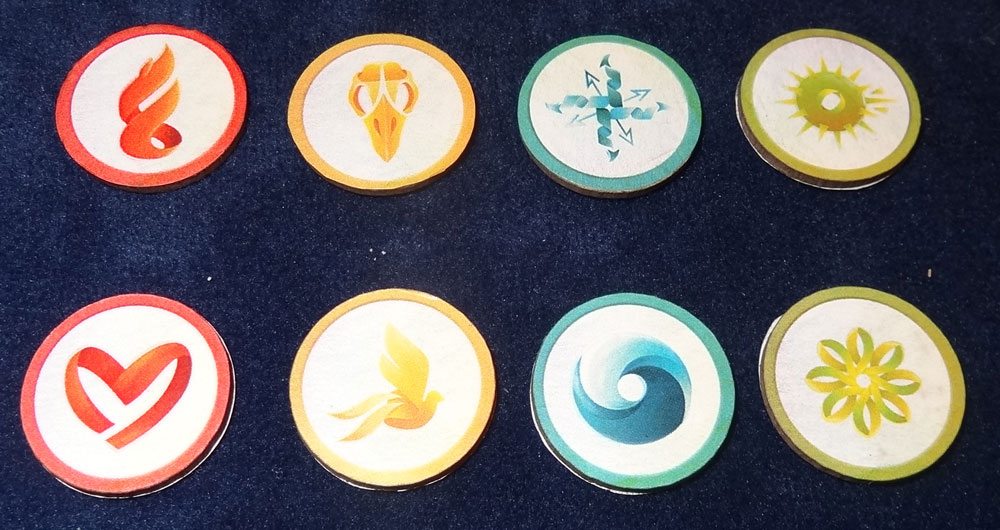
The emotions have four different “vibes” (represented by four colors–red, yellow, blue, and green). The vibes each have their own icons, which differ between the Bliss and Gloom versions. I like that the icons are related: the red vibe looks like a ribbon, but it’s a flame for Gloom and a heart for Bliss.

The identity fragments are plastic pentagons that stack on each other in the center of the main board: blue for Gloom and red for Bliss. They form a column in the center of the board, and there are minor and major versions. The major fragments are thicker, and have some symbols on the faces, including one extruded symbol that marks which direction the fragment is facing. The top piece is used at the end of the game, potentially capping off the tower for one of the teams. The pieces pictured here are prototypes only, but give you a good idea of how they will function.
The base version includes cardboard standees for the 8 spirits, but the higher pledge version will have plastic miniatures, and there’s even an option for fully painted miniatures, which look really fantastic. They’re not required to play the game, of course, but if you prefer plastic miniatures, you’ll probably want to take a look.
How to Play Cerebria
You can download a draft of the rulebook here.
The Goal
The goal of the game is to score the most identity fragments by the end of 5 rounds, or be the first to score 3 major fragments.
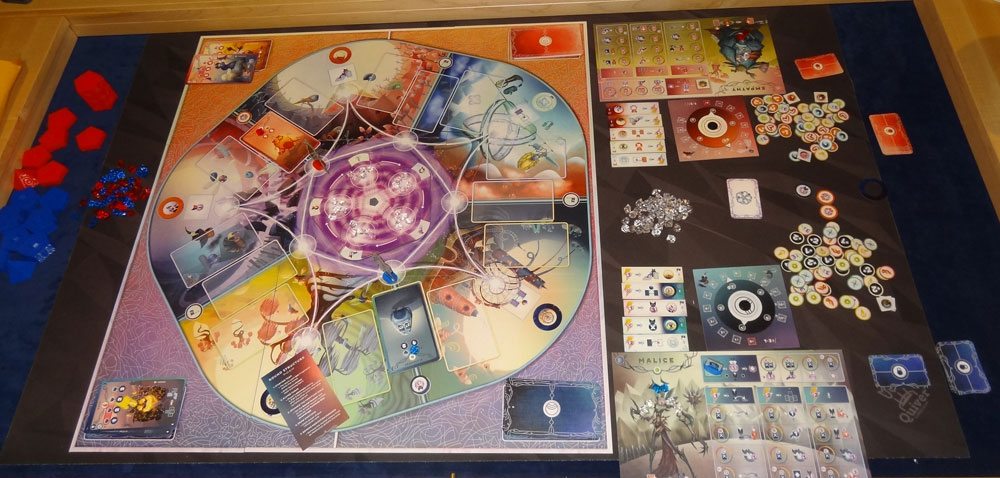
Setup
The board goes in the center of the table, with Bliss players on one side and Gloom players on the other side. The center of the board has a rotating pentagon called the origin, with five spheres on the corners. Place 5 willpower in each of these spheres. Flip one of the common aspiration cards face-up. Each team also draws one of their team aspiration cards and looks at it secretly. If it matches the common aspiration, draw a new one and shuffle the matching one back into the deck.
You also set aside one common aspiration cards face-up, and one face-down from each team. (Again, if your team card matches the common card, draw a new one and shuffle the first one back in.) These will be used in end-game scoring.
Each player takes a spirit board and the corresponding spirit standee. The emotion cards are divided into mild and strong emotions, and further into two decks per faction (marked with a small dot or moon icon); each player will get one deck of cards. Shuffle the mild emotions to form your own deck, and set the strong emotions aside face-up. There are also some Brightness and Bleakness emotion cards that are used during intial setup and are not shuffled into the decks.
You start with 4 willpower (the clear plastic crystals), 2 essence (the blue/red crystals), and a hand of 3 mild emotion cards. Choose a starting team; players on the other team will each get 1 extra willpower as compensation.
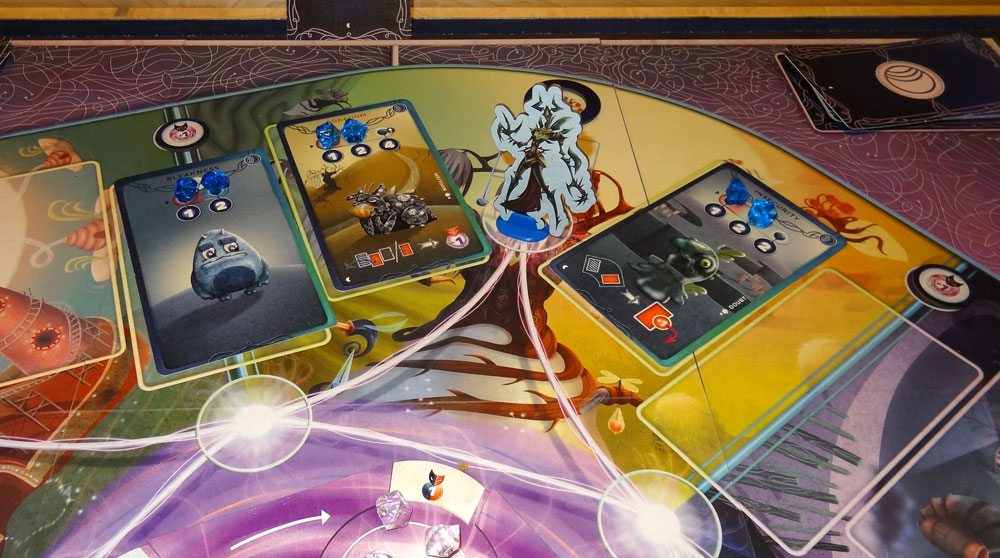
To begin, teams will take turns (starting with the team that will play second) to place their spirits onto the board, and then adding Brightness (Bliss) or Bleakness (Gloom) emotions to the board near their spirits. The board is divided into five regions called realms, and the borders between them are called frontiers; as you play emotions into the emotion slots around the board, the two sides will gain and lose control of the frontiers and realms, which are marked with rings and tokens around the outside of the board.
Each team has five realm action tiles, which correspond to the five realms on the board: the Valley of Motives, the Cradle of Senses, the Network of Thoughts, the Land of Desires, and the Willow of Values. If you control a realm, you flip the tile over (to the side that shows your color on the tile)–the willpower cost of taking that action will be one less.
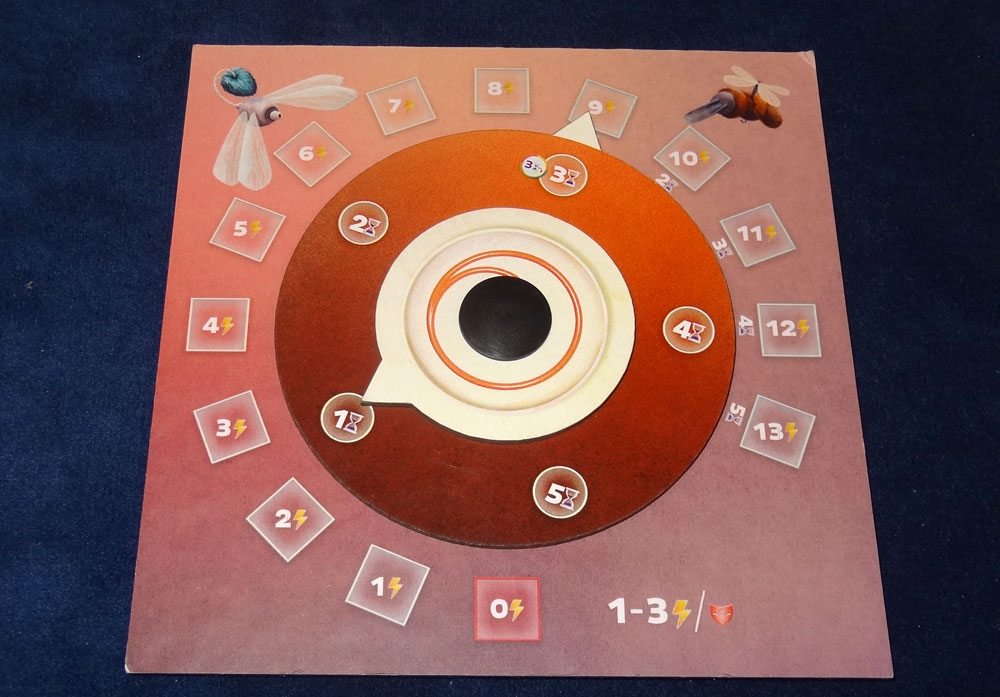
Round Order
Cerebria will be played in up to 5 rounds. Each round, play alternates between teams until both teams are out of fortitude, which is essentially how many actions you can take. On the first round, teams start with 9 fortitude, and in each subsequent round teams will start with more. Fortitude is shared between the two players on each team. The team that has fewer identity fragments goes first; if it’s a tie, the team that ran out of fortitude first in the previous round will go first. (The first round is randomly determined.)
On each turn, your team may take 1, 2, or 3 actions, spending a fortitude for each action. Players may decide which of the team members goes first in the first round of the game, and then play will alternate between team members.
At the end of the round, when everyone is out of fortitude, you wrap up:
- Advance the fortitude dials to increase the round counter and reset to the new fortitude limit.
- Each player draws 1 emotion card.
- Remove meditation markers from the meditate action.
Spirit Actions
You have 9 different actions available to you on your turn: 5 are based on the main board, and 4 are based on your spirit board. Every action requires 1 fortitude, with varying willpower costs.
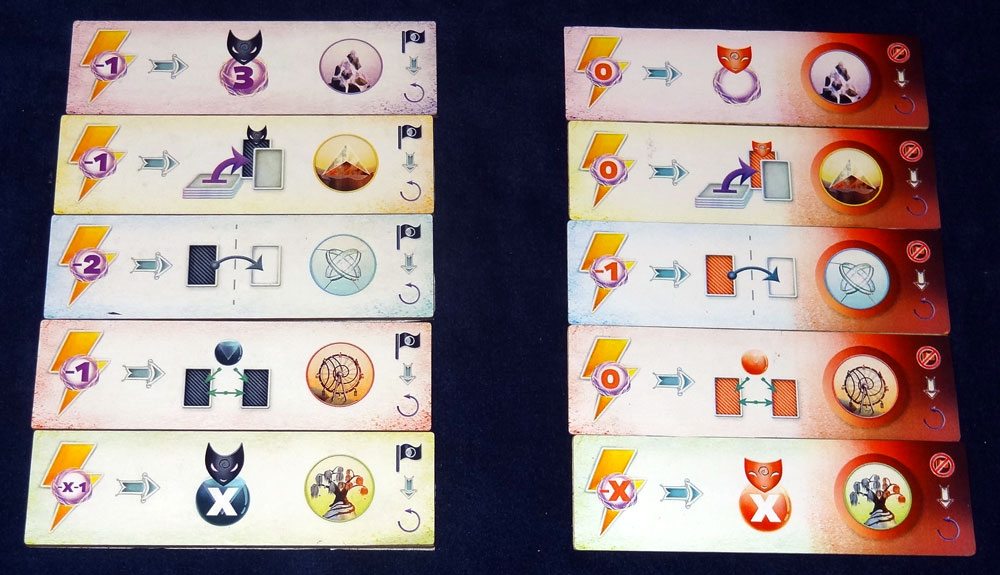
Main Board Actions
The main board actions cost 1 less willpower if you control the corresponding realm. Here are the actions (from top to bottom in the image above):
- Gain Willpower: spend 1 willpower and gain 3 willpower from the general supply.
- Draw Emotion: spend 1 willpower and draw 2 emotion cards; keep one and discard the other.
- Move Emotion: spend 2 willpower and move one of your team’s emotions from anywhere on the main board to an empty slot next to your spirit.
- Intensify Emotion: spend 1 willpower and place 1 essence from your reserve onto an emotion adjacent to your spirit. Essence is filled in from left to right on the cards, and may change the intensity of the emotion, which is used to control realms and frontiers. If you place an essence on the spot marked with the upgrade icon, you may draw the strong version of that emotion into your hand (if available).
- Harvest Essence: spend any amount of willpower, and then get 1 less essence than the amount of willpower you spent.

The emotions have mild and strong versions, though you won’t have strong versions of all of your emotions available in every game. As you place more essence on an emotion card, the intensity (represented by the numbers in the circle) may change, which then affects control over realms and frontiers. If there is ever no essence left on an emotion, the emotion is removed from the board and discarded.

Also, each emotion has its own special power–strong emotions generally have a more powerful version of the same power.
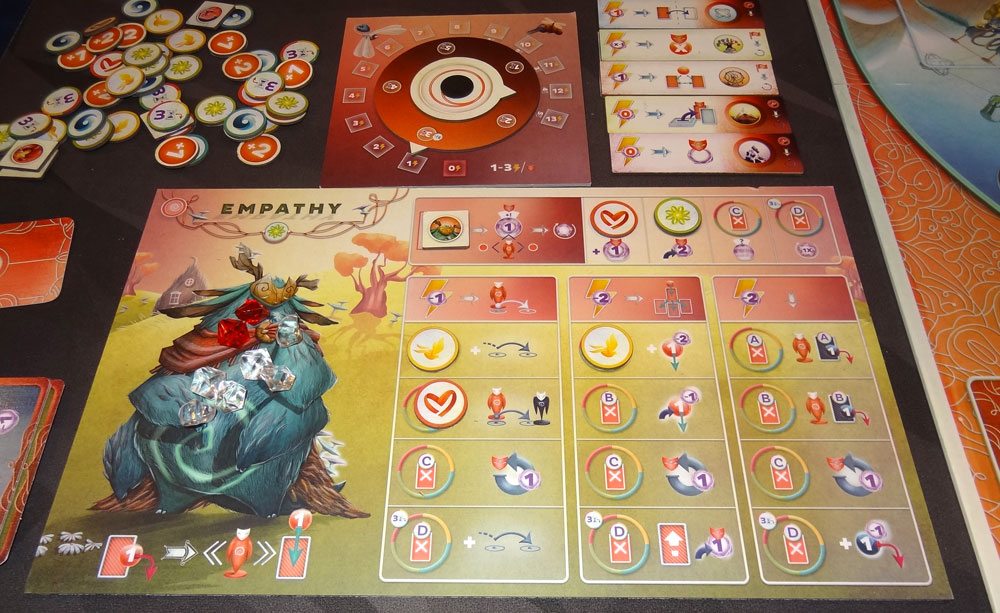
Spirit Board Actions
Your spirit board has four actions available. Before taking a spirit board action, you may choose to upgrade it by discarding an emotion card (or two, in some cases) from your hand. Place a vibe token matching the emotion’s vibe on the upgrade slot. The upgrades for each action must be taken in order, and you must use four different vibes per action. The last upgrade for each action is only available starting from the third round.
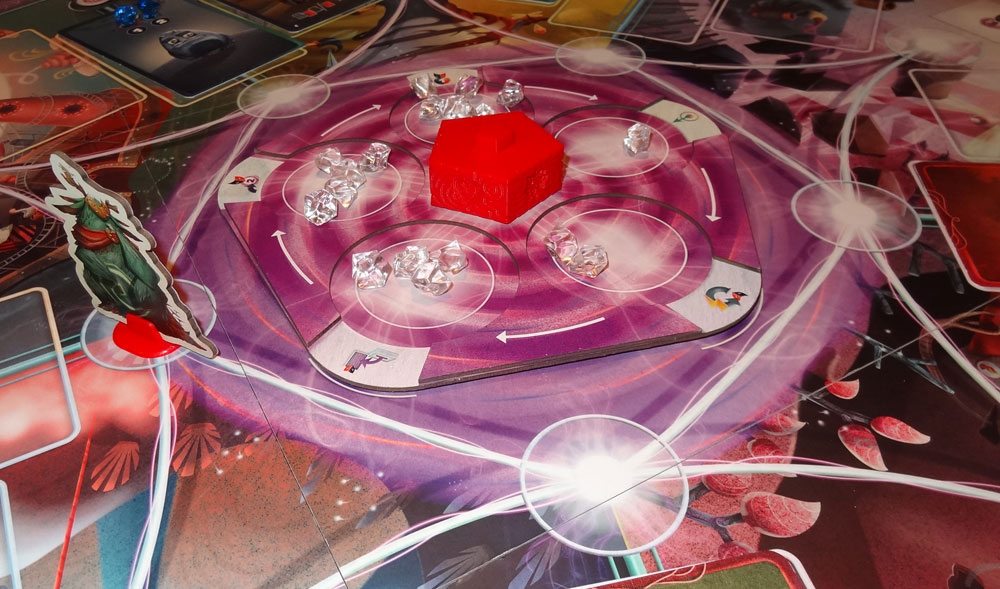
The four actions are:
Meditate: Gain willpower from one of the two origin spheres adjacent to you, and then rotate the origin board clockwise one step. You will also gain a bonus depending on which sphere you took from. This action can be upgraded to gain even more willpower, to take any sphere’s bonus, and to optionally rotate the origin board one step before you take willpower. You may only meditate once per round–then you mark your meditate action with a token.
Move: Spend 1 willpower and move your spirit 1 space. The spirits move along the glowing white lines on the board. This action may be upgraded to allow you to move further, end your move in the same space as an opposing spirit, and get one of your spent willpower back at the end of the round.
Invoke Emotion: Spend 2 willpower to place an emotion from your hand onto an empty slot adjacent to your spirit. You must place 1 essence on each of the red essence spots on the card. (Some essence slots have a red background and some do not.) If you can’t afford to fill the red slots, you may not place that emotion. This action may be upgraded to allow you to spend additional willpower to place more essence, to get a spent willpower back at the end of the round, and to allow you to replace a mild emotion on the board with its strong counterpart.
Quell Emotion: Spend 2 willpower to remove an essence from an emotion adjacent to your spirit. You may only quell emotions of certain vibes, however: the first two upgrades on this action determine the two vibes that you are able to quell. The other upgrades allow you to regain spent willpower, and remove an additional essence by spending more willpower. (Note that you may discard an upgrade before upgrading an action, in case you want to switch vibes in the first two upgrade slots.)

Revelation and Identity Fragments
The ultimate goal of the game is to score identity fragments, locking in Bliss or Gloom into the mind’s personality. This is done by triggering revelations.
Any time one of the origin spheres is emptied of willpower, a revelation occurs. Each team reveals their own aspiration card and checks to see if they have met the requirement. Also, check to see if either team has met the goal on the common aspiration card.
The seven possible goals (left to right, top to bottom in the photo above) are:
- Frontier Presence: Have emotions on more frontiers.
- Unity: Have a longer uninterrupted chain of emotions.
- Frontier Control: Have control of more frontiers.
- Total Essence: Have more essence on the main board.
- Spirit Upgrades: Have more spirit upgrade tokens on your spirit boards.
- Realm Control: Have control of more realms.
- Different Vibes: Have more different vibes on emotions on the main board.

Fragments are placed based on how many goals each team achieved:
- If nobody scores any goals, no fragments are placed.
- If both teams score 1 goal each, then each team places 1 minor fragment.
- If the teams score 2 and 1, then the team that scored 2 places 1 minor fragment.
- Finally, if one team scores 2 and the other scores none, the winning team places 1 major fragment, facing the sphere that was just emptied. When you have a major fragment facing a sphere, you get to double the benefit of that sphere when you meditate.
After fragments are scored, the sphere is refilled with 5 willpower (plus 1 willpower for each major fragment facing that sphere). The common goal is discarded and a new one is drawn face-up. If you scored your team goal, you discard and draw a new one (replacing if it matches the common goal). If you didn’t score your team goal, you discard it and then choose a new one from your deck (as long as it’s different from the common goal).
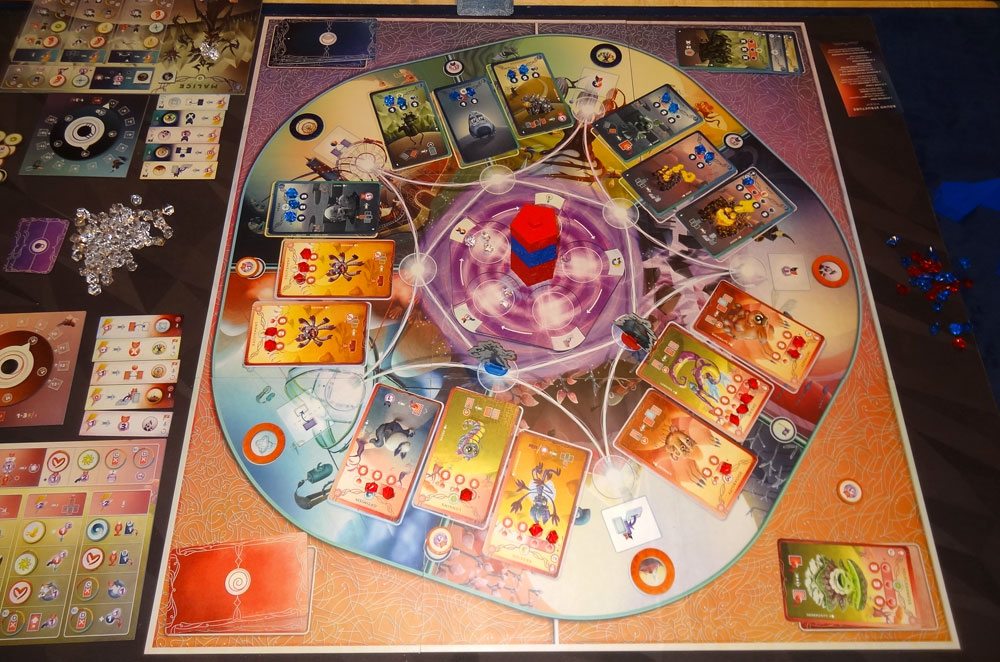
Game End
If either team scores three major identity fragments, that team wins and the game ends immediately.
Otherwise, at the end of 5 rounds, there will be one more revelation based on the set-aside aspiration cards. If only one team would score a fragment, their top piece is placed.
Score the fragments:
- Minor fragments are worth 2 points.
- Major fragments are worth 3 points.
- A top piece is worth 4 points.
- Each fully upgraded spirit action is worth 1 point.
- Each Strong Emotion is worth 1 point.
- Each emotion that has been totally filled with essence is worth 1 point.
The higher score wins; in the case of a tie, Cerebria is in perfect balance between Bliss and Gloom.
Variants
The game is intended to be played with 2 teams of 2 players each, but there are variants for 2 or 3 players as well. If you’re on a team by yourself, you draw 2 emotion cards at the end of each round, and you may meditate twice per round (though not on the same turn). The amount of fortitude you get each round is also adjusted.
There is a stretch goal for a solo/co-op mode, though the rules for that were not finalized as of the time of this writing.
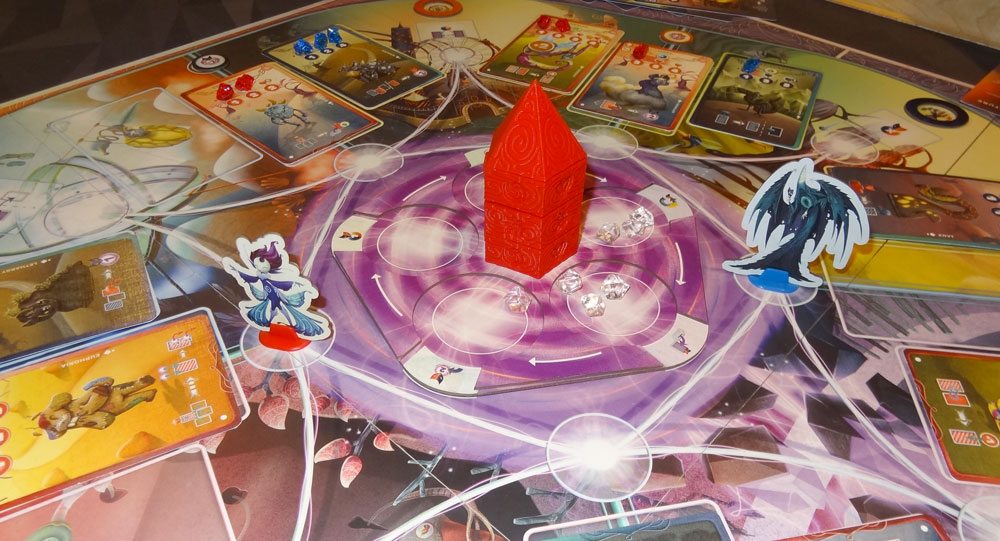
Why You Should Play Cerebria
Cerebria is a beautiful, complex game about the inner workings of a mind, as Gloom and Bliss vie for dominance. I love the way that the card abilities reflect the various competing emotions and mental states. For instance, when you place Courage (a Bliss emotion) on a frontier that is currently controlled by Gloom, you gain 2 willpower. Suspicion (a Gloom emotion) gains extra intensity if there’s a Bliss emotion in the same realm. The two factions have different sets of abilities that really do feel like Bliss and Gloom battling it out within a person’s mind. I also like the way mild emotions can become strong emotions—and the way the illustrations depict the creatures “growing” bigger.
The theme reminds me a little bit of the film Inside Out, though in this case you generally aren’t out to achieve perfect balance between Joy and Sadness. The realms are reminiscent of the “islands” in the movie, with emotions taking up positions to guard them from opposing emotions.
Cerebria is designed and published by the same team behind Anachrony, a time-travel game that can also look overwhelming when you first see it all laid out. Both games are visually stunning and fairly complex, with a whole lot of moving parts and lots of icons that you won’t understand right at first. It’s not the sort of game you can just sit down and start playing right away; rules explanation will take probably about 15–20 minutes, so if your gaming group gets impatient then it might not be the right title for you. There are so many things to keep track of that it’s easy to forget to turn the fortitude dial after you perform an action, or reassess control over frontiers and realms after you quell an emotion.
Overall, though, I did think that the many moving parts fit together well, and I’m eager to play it more now that I’ve become more familiar with the emotions’ effects. Players who do enjoy complicated games may really like the way the various parts of the board fit together, and the way you need to figure out the logistics of getting your spirits positioned in the right places to achieve your aspiration goals. It’s an interesting take on area control, because for each revelation there are some specific aspects that you want to control—and they may be different from what your opponents are doing. Being able to trigger the revelation on your timing is more important to victory than trying to fight the battle on all fronts at once.

The finished version of Anachrony is really quite impressive, and I expect no less from Cerebria. Getting the miniatures (especially the painted ones) is a splurge for sure, but they look pretty amazing and would make the game even more spectacular on your table. Speaking of tables, be sure to reserve plenty of table space for this one—you’re not going to be able to play it on a regular card table, for sure!
If you love the idea of emotions striving to form a personality, and you’re willing to invest a bit of time and mental energy in learning to play, Cerebria is worth a closer look. It’s really intriguing and lovely.
For more information about the game or to make a pledge, visit the Cerebria Kickstarter page.
Click here to see all our tabletop game reviews.
Disclosure: GeekDad received a copy of this game for review purposes.





